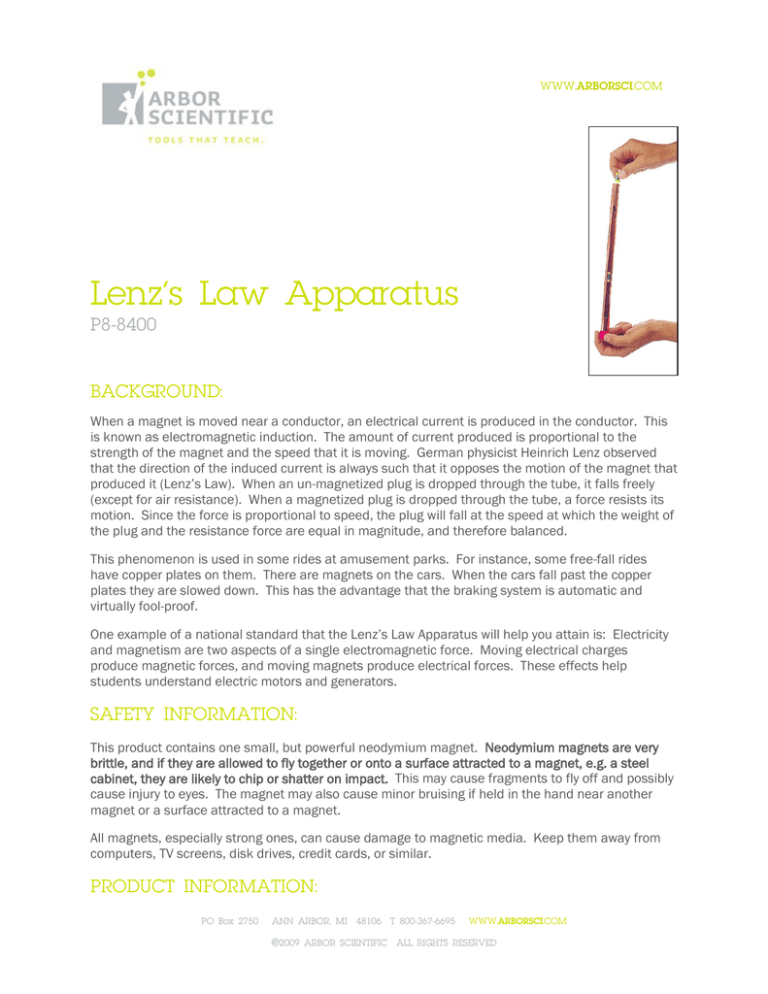
WWW.ARBORSCI.COM
Lenz’s Law Apparatus
P8-8400
BACKGROUND:
When a magnet is moved near a conductor, an electrical current is produced in the conductor. This
is known as electromagnetic induction. The amount of current produced is proportional to the
strength of the magnet and the speed that it is moving. German physicist Heinrich Lenz observed
that the direction of the induced current is always such that it opposes the motion of the magnet that
produced it (Lenz’s Law). When an un-magnetized plug is dropped through the tube, it falls freely
(except for air resistance). When a magnetized plug is dropped through the tube, a force resists its
motion. Since the force is proportional to speed, the plug will fall at the speed at which the weight of
the plug and the resistance force are equal in magnitude, and therefore balanced.
This phenomenon is used in some rides at amusement parks. For instance, some free-fall rides
have copper plates on them. There are magnets on the cars. When the cars fall past the copper
plates they are slowed down. This has the advantage that the braking system is automatic and
virtually fool-proof.
One example of a national standard that the Lenz’s Law Apparatus will help you attain is: Electricity
and magnetism are two aspects of a single electromagnetic force. Moving electrical charges
produce magnetic forces, and moving magnets produce electrical forces. These effects help
students understand electric motors and generators.
SAFETY INFORMATION:
This product contains one small, but powerful neodymium magnet. Neodymium magnets are very
brittle, and if they are allowed to fly together or onto a surface attracted to a magnet, e.g. a steel
cabinet, they are likely to chip or shatter on impact. This may cause fragments to fly off and possibly
cause injury to eyes. The magnet may also cause minor bruising if held in the hand near another
magnet or a surface attracted to a magnet.
All magnets, especially strong ones, can cause damage to magnetic media. Keep them away from
computers, TV screens, disk drives, credit cards, or similar.
PRODUCT INFORMATION:
PO Box 2750
ANN ARBOR, MI 48106 T 800-367-6695
WWW.ARBORSCI.COM
©2009 ARBOR SCIENTIFIC ALL RIGHTS RESERVED
The Apparatus consists of a copper tube with a narrow transparent slot along its length, a cylindrical
plug of magnetized Neodymium Iron Boron (NdFeB), and an un-magnetized plug of identical material,
size, and weight. The purpose of the apparatus is to show that a magnetized plug falls very slowly
down the tube, whereas a non-magnetized, but otherwise identical, plug falls freely through the tube.
The yellow ends of the plugs make them easy to see through the transparent plastic slot and help
protect against chipping.
ACTIVITIES:
To determine which of the plugs is magnetic, hold them close to a paper clip. The one that will pick it
up is magnetized. (The un-magnetized plug cannot be magnetized by the magnet. It needs a much
stronger field than the magnet can provide. It can only be magnetized by a strong electromagnetic
coil.)
Weigh the two plugs to show that they are indeed the same weight. Drop them onto a soft surface to
show that normally they will fall at the same rate. Remove the red end-caps from the tube. Drop the
un-magnetized plug, then the magnetized plug through the tube. Make sure the catch them with
your hand or something soft. The magnetized plug will fall much more slowly through the tube and
can be observed through the opening.
Have the students hold the un-magnetized plug near a piece of aluminum and then move it back and
forth. Repeat this with the magnetized plug. When stationary, there is no attraction between the
magnet and the aluminum, but when the magnet is moved, there is a force that resists the motion.
(Just like when the plug is falling through the tube.)
RELATED PRODUCTS:
Electrical Current and Field Kit (P8-8008). The kit shows that a magnetic field is created by
an electric current.
World’s Simplest Motor (P8-8300). Ideal for introducing students to electricity and
magnetism, this low-cost kit is used to build an electric motor.
PO Box 2750
ANN ARBOR, MI 48106 T 800-367-6695
WWW.ARBORSCI.COM
©2009 ARBOR SCIENTIFIC ALL RIGHTS RESERVED






